What to do if spots appear on the leaves of the ficus?

No matter how well the plant breeder takes care of the ficus, it happens that spots appear on the foliage. They can be not only brown, but also white. Their appearance is not always associated with fungal or other infection; sometimes it is simply necessary to give the plant high-quality care. To know how to fix the problem, if the ficus is sick, the leaves have wilted, it is important to learn how to identify the source of the problem.
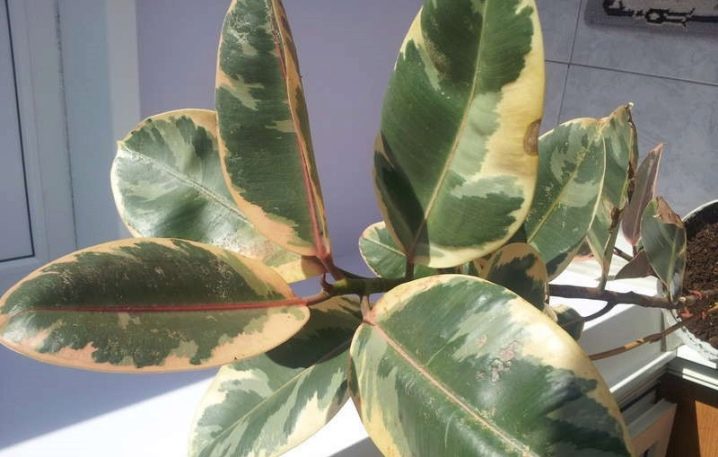
Black spot
Black spots on the top of the ficus tree are the first sign that a fungal disease is infecting the tree. They initially appear as dark and indistinct on the upper side of the leaves. A yellow ring forms almost immediately around the outer edge. Eventually, the entire leaf turns yellow, dies and falls off the tree. The spots can spread to other trees if the disease is left untreated.

Fungicide is the best remedy for black spot outbreaks on ficus trees. Scientists and breeders recommend fungicidal treatment with chlorothalonil. It is a broad spectrum drug. Treatment frequency - spraying the leaves every 7-10 days. Be sure to read the instructions for use on the bottle to know the amount and frequency recommended by the manufacturer. Shake the bottle before using the fungicide.
Chlorothalonil is toxic and should not be sprayed indoors. After that, the infected leaves are removed and destroyed to prevent the spread of spores to other trees.
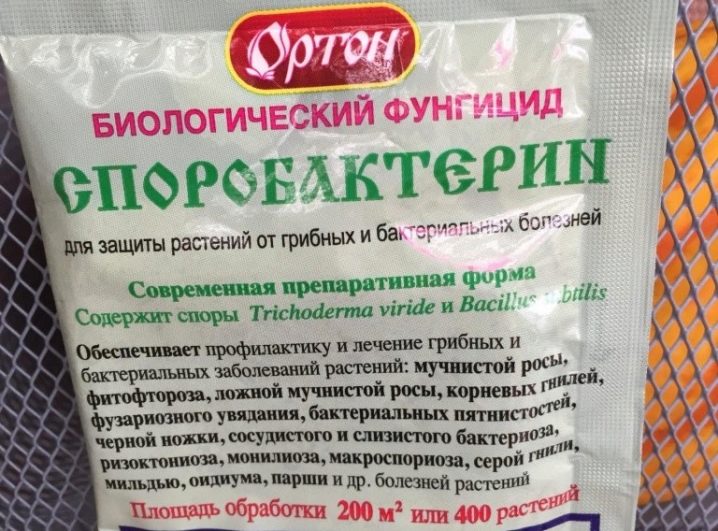
Brown spots
Brown spots on the leaves can be caused by root rot. This is the most common cause of brown leaves, usually due to waterlogging. Too frequent watering and poor drainage cause rot that spreads from the roots to the leaves of the plant. The only way to be sure that the ficus has this disease is to check the roots. If they have brown spots, you will need to not only cut off the damaged ones, but also change the pot of soil.
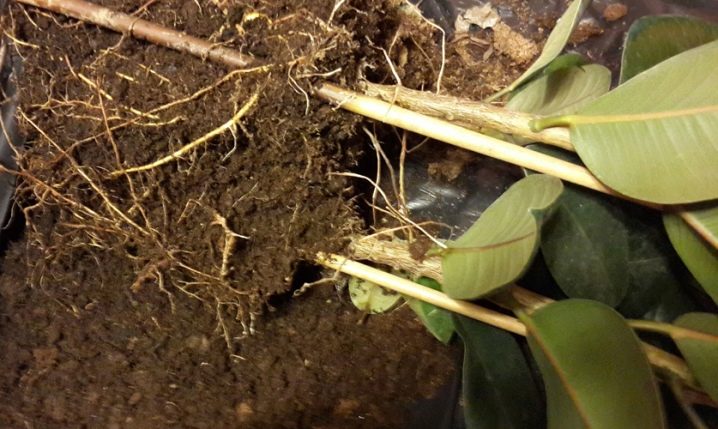
One of the interesting things about root rot is that it tends to affect older leaves first. Another key symptom is a falling crown.
The defeat can start with small black dots, then grow. It is worth using a moisture meter, take moisture readings at the base of the roots. As a rule, root rot is curable, especially if you react early to the problem. Make sure you have a well-draining container, fast-draining potting soil, and that you don't water too often.
Brown spots on the leaves can appear from a bacterial infection. It is one of the most difficult problems with which it is almost impossible to fight, since effective drugs do not yet exist. A key characteristic of bacterial brown spots is that they are less black and more brown in color.

The bacterial spot attacks any part of the plant, including large leaves, young ones. If new shoots appear with slow growth, yellowing and brown spots, they must be removed immediately. Such formations have irregular margins and can occur anywhere, including at the edge of the leaf or where it meets the stem. In this case, you will need to remove the plant, since it will not be possible to cure it.
Sometimes rough, dried out spots appear on the foliage. They indicate direct sunlight, which simply burns out the greens.In this case, it is worth hanging a curtain on the window or just pulling it up so that the light is diffused.
Edema is a physiological disorder that occurs when a ficus plant consumes too much water. The disease initially appears as water-soaked buds on the undersides of leaves. The cells burst, forming brown, brownish-red, yellow or black spots with a rough cork-like texture. Milk sap flows out of the plant, causing additional dots to form as it dries.
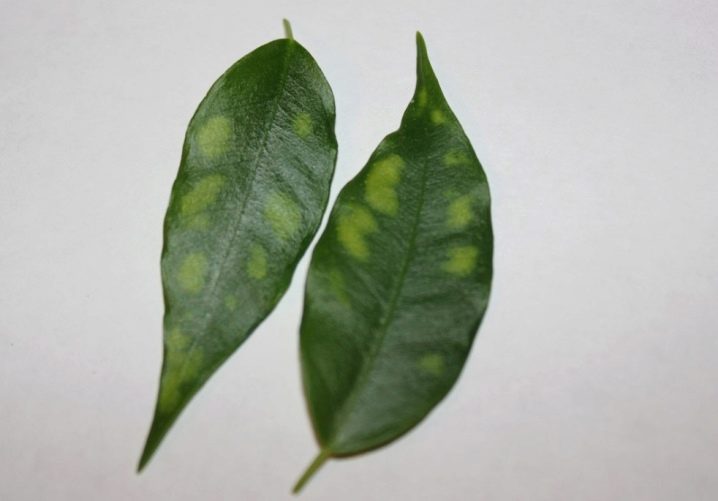
This problem can make the plant unattractive, but rarely kills the ficus. Although the affected leaves cannot be cured, the spread of edema to new shoots can be avoided by reducing watering and allowing the flower to dry out. In this case, it will be necessary to avoid wetting the leaves during watering, increase the amount of light and improve ventilation.
It should always be remembered that ficus is not tolerant of movement and changes in the amount of light, which can lead to the fact that its leaves become covered with brown spots and then die. Dying off makes the flower vulnerable to other diseases and pests. Control is the only way to avoid the problem.
Cold damage and frostbite also make young leaves appear distorted or shriveled and brownish, while older shoots develop large brown spots. It is required to avoid such trauma to the flower, do not place it near an air conditioner or ventilation openings. Do not leave the ficus container outside if the temperature drops below 5 degrees Celsius. Ficus also responds to inconsistent watering. Too much or too little water can lead to the indicated problem. Fertilizers with a high nitrogen content should be avoided.
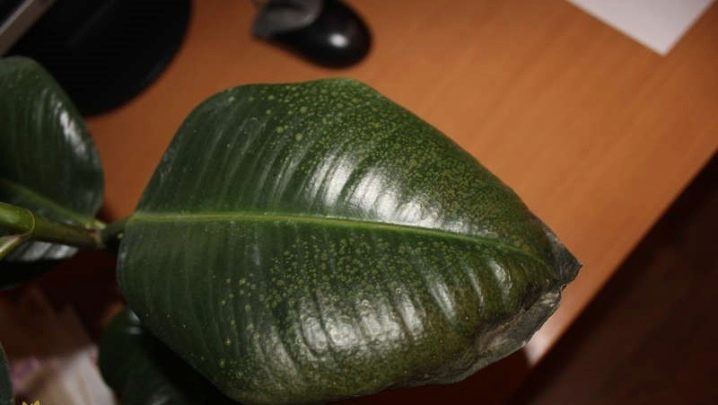
White spots
Some diseases, such as powdery mildew, cause white spots on ficuses. This fungal infection is often the result of infestation by insects, which have white scales when they live on plants. Powdery mildew can also cause symptoms such as white fungal bloom on the crown and stems, and leaf curling. It is easy to control using fungicides.
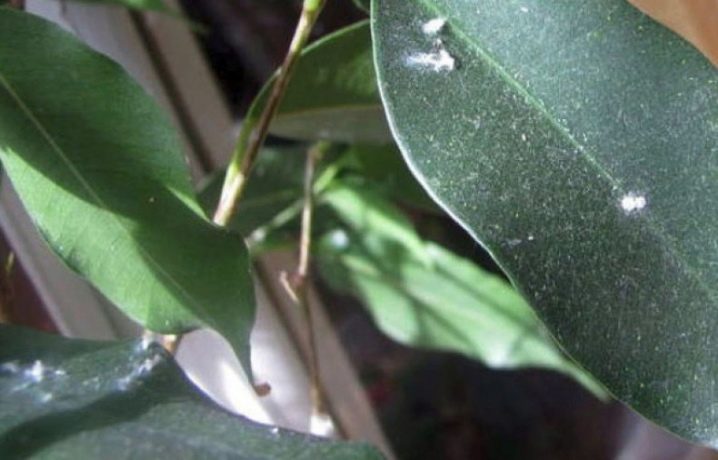
The use of funds should occur at the first sign. Insects tend to be more difficult to control. Spraying should be done with insecticides, you can get rid of most of the problems by simply increasing the humidity or with a soapy, alcohol solution, garden oils do very well. Sometimes you can see small waxy spots on the foliage, more often than not this is quite normal, so there is no reason to worry.
At first, the spots can be confused with diseases or pests, but in fact, for the ficus, the appearance of such spots is normal. Some growers have concluded that this is either the plant's way of getting rid of minerals and salts in the soil, or it attracts pollinators. The white spot goes away by itself, but if you wish, you can simply wipe it off.

Yellow spots
Yellowing leaf edges are usually a symptom that gradually spreads to new leaves. In most cases, it is caused by prolonged underfeeding of the plant. To solve the problem and prevent further development, it is necessary to choose the right complex fertilizers, however, you should not exceed the dose in order to compensate for the previous error, otherwise you can do more harm.

In any case, you must follow the instructions on the package or bottle and not exceed the stated dose.
Small small red spots are a sign of the appearance of a tick, which pierces the leaf with its proboscis and feeds on the sap of the plant. The problem can be eliminated by using specialized drugs. Anthracnose caused by Colletotrichum or Glomerella causes yellow spots that darken to brown. It is very difficult to get rid of the disease, you will have to make a lot of effort. It is best to apply an insecticide treatment, but do it outdoors.
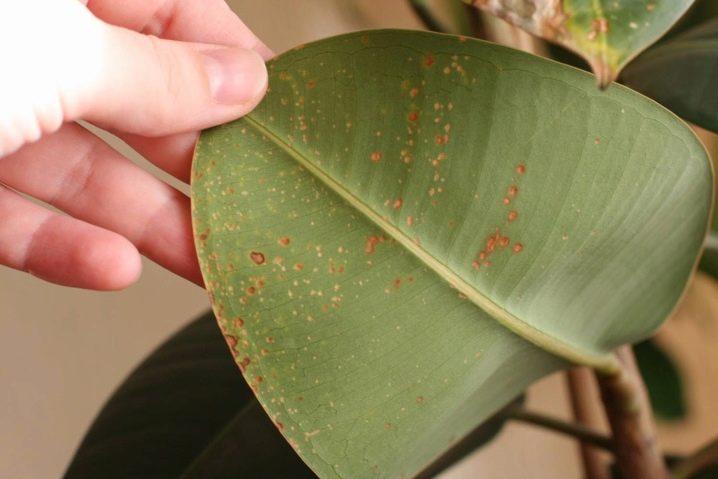
Anthracnose spreads through water.Control measures include selecting disease-resistant varieties, preventing leaves from watering or getting wet, and planting or placing ficus in areas with good air circulation. Chemical control involves the use of fungicides with mancozeb at the first sign of illness.
Other stains
Botrytis forms large rusty spots with concentric rings. Tiny, slightly raised, dark green or red formations on the underside of the leaves are the main symptoms of this disease. Corynespora spots may appear on young shoots as large reddish dots. There are several other fungal diseases that affect ficuses just as often. Fungal ulcers are crusted lesions that can encircle and kill the shoots.
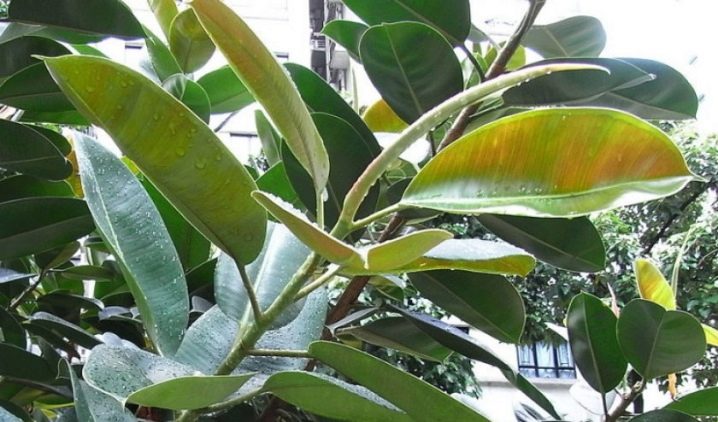
The fungus Sclerotium rolfsii causes rot, white cotton mycelium with such an infection grows not only on the stems, but also on the leaves of plants and causes their death. There are no chemical agents to prevent or treat this problem. If the ficus is covered with such spots, it must be destroyed. All bacterial diseases are fatal. Agrobacterium tumefaciens causes slightly swollen patches on infected leaf veins, stems, or roots. Xanthomonas starts out as tiny water-soaked spots on foliage. They grow rapidly and may have bright yellow edges. In this case, it is possible to use bactericides.

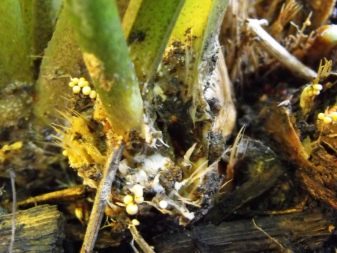
See below for proper care of ficuses.































The comment was sent successfully.